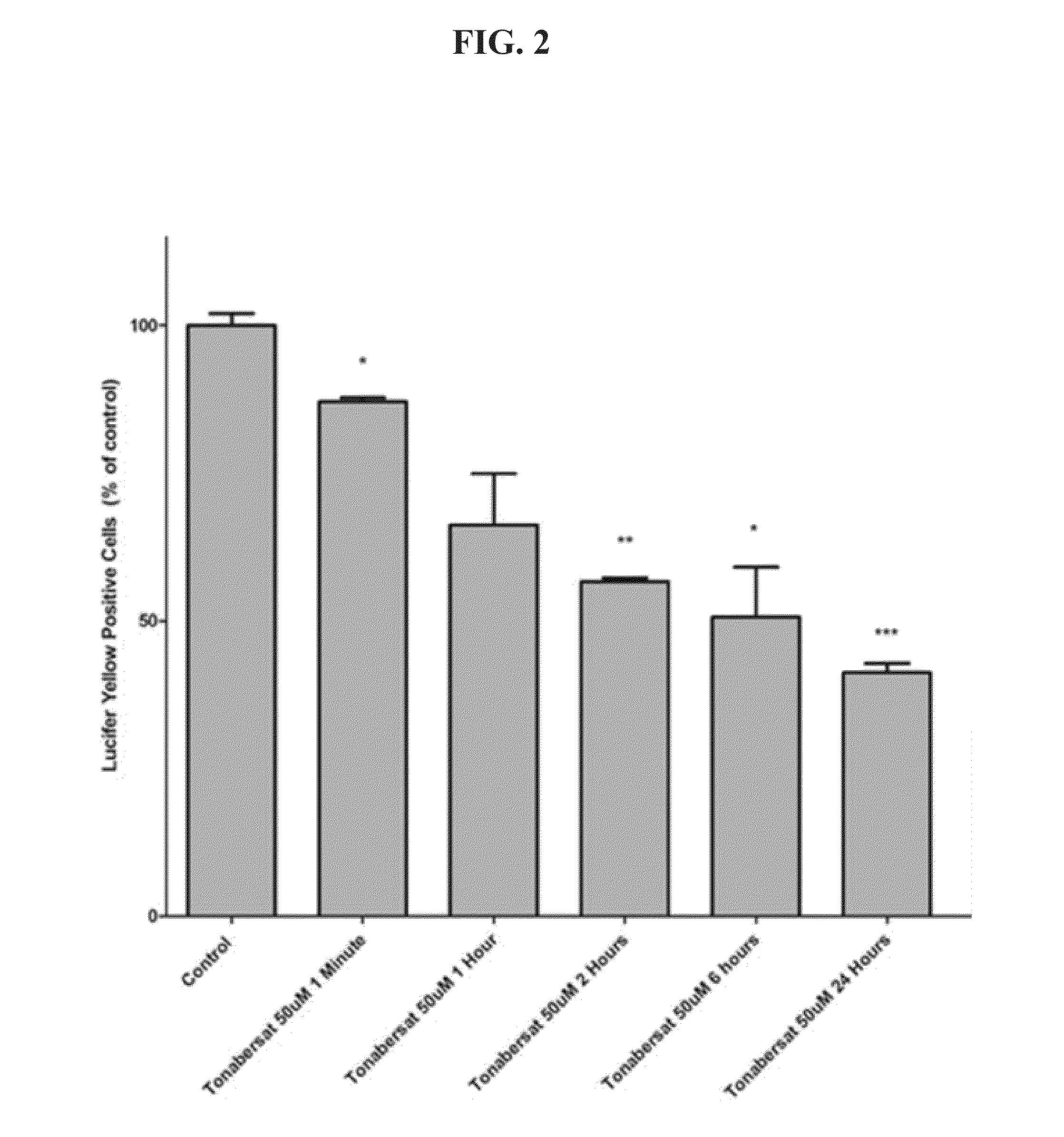Channel modulators
a technology of channel modulators and pannexin, which is applied in the direction of antibody medical ingredients, peptide/protein ingredients, elcosanoid active ingredients, etc., can solve the problems of pannexin proteins interfering with the docking process, and achieve the effect of improving the success rate of trabeculectomy
- Summary
- Abstract
- Description
- Claims
- Application Information
AI Technical Summary
Benefits of technology
Problems solved by technology
Method used
Image
Examples
example 1
Methods and Materials for hCMVEC and ARPE-19 Cell Studies
[0584]In the below Examples 2, 4, 5, 8 and 10 using human cerebral microvascular endothelial cells (hCMVEC), cells were prepared by growing them in collagen coated (30 g / mL) T25 or T75 flasks maintained in Medium M199 supplemented with 10% FCS, 1 μg / mL hydrocortisone, 3 ng / mL hFGF, 1 ng / mL hEGF, 10 μg / mL heparin, 1× penicillin streptomycin neomycin (Life Technologies), and cAMP (100 μL 100% cAMP to 100 mL media). Cells were maintained at 37° C. with 95% O2 and 5% CO2.
[0585]In the below Examples 3, 6 and 7 using human retinal epithelial (ARPE-19) cells, the cells were grown in DMEM / F:12 (Invitrogen), supplemented with 10% fetal calf serum (FCS), 100 units / mL of penicillin, 100 μg / mL of streptomycin, and 0.25 μg / mL of Fungizone® Antimycotic (Invitrogen).
[0586]With respect to the chemicals used in these studies, tonabersat (Medchemexpress, USA) was dissolved in dimethyl sulfoxide (DMSO) at a stock concentration of 100 mM. Ammoniu...
example 2
Scrape Load Assay
[0588]In this Example, human cerebral microvascular endothelial cells (hCMVEC) were grown in collagen coated (1 μg / mL) T25 flasks maintained in Medium M199 supplemented with 10% FBS, 1 μg / mL hydrocortisone, 3 ng / mL hFGF, Ing / mL hEGF, 10 μg / mL heparin and cAMP (100 μL 100% cAMP to 100 mL media) in a humidified atmosphere at 37° C. with 5% CO2. One day prior to experimentation, these cells were trypsinized and plated at a density of 4×105 cells / well in a collagen-coated 12 well-plate in the same medium. For treatments, cells were cultured in the presence of peptide5, a control gap junction channel blocker (carbenoxolone), or tonabersat for the respective time intervals prior to scrape dye loading. The blockers were also present in the respective scrape loading solutions.
[0589]For scrape loading the hCMVEC cells were washed three times with phosphate buffered saline (PBS) (without divalent cations). A solution of PBS+0.05% lucifer yellow was added to cells. The cells t...
example 3
Immunohistochemistry of ARPE-19 Retinal Epithelial Cells Treated with Peptide5 and Tonabersat
[0593]Cells were seeded at 0.05×106 per well in 8-well sterile glass microscope chamber slides (Falcon, Corning Life Sciences), and the monolayer was labeled for connexin expression at ˜90-100% confluency. The following steps were conducted at room temperature. Cells were fixed in 4% paraformaldehyde (P6148, Sigma-Aldrich) in PBS with 0.1 mM CaCl2 for 10 min, and washed three times in PBS with 0.1 mM CaCl2. After blocking in 10% normal goat serum in PBS with 0.1 mM CaCl2 for one hour, cells were incubated overnight in primary antibody solution (rabbit anti-Cx43, Sigma C6219) diluted in PBS with 0.1 mM CaCl2. The chamber slides were then washed three times with PBS containing 0.1 mM CaCl2 for 10 minutes, and incubated for a further 45 minutes in goat anti-rabbit Alexa 568 conjugated secondary antibody (Invitrogen #A11036). Cells were counter labeled with DAPI for 5 minutes and washed three ti...
PUM
| Property | Measurement | Unit |
|---|---|---|
| mean particle size | aaaaa | aaaaa |
| mean particle size | aaaaa | aaaaa |
| intraocular pressure | aaaaa | aaaaa |
Abstract
Description
Claims
Application Information
 Login to View More
Login to View More - R&D
- Intellectual Property
- Life Sciences
- Materials
- Tech Scout
- Unparalleled Data Quality
- Higher Quality Content
- 60% Fewer Hallucinations
Browse by: Latest US Patents, China's latest patents, Technical Efficacy Thesaurus, Application Domain, Technology Topic, Popular Technical Reports.
© 2025 PatSnap. All rights reserved.Legal|Privacy policy|Modern Slavery Act Transparency Statement|Sitemap|About US| Contact US: help@patsnap.com



